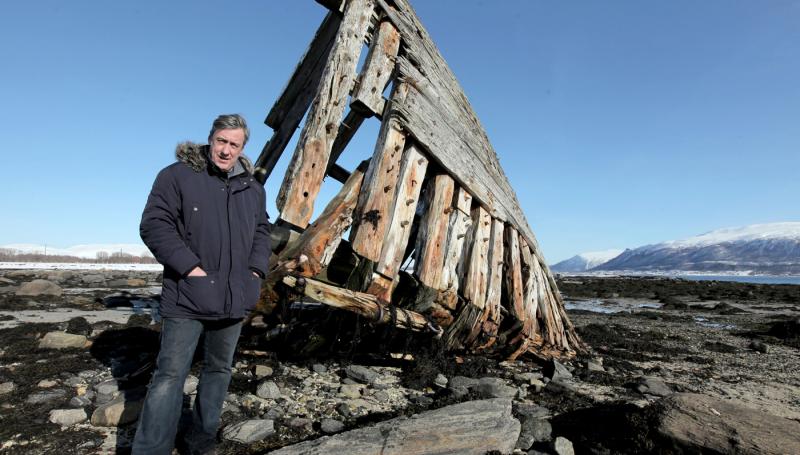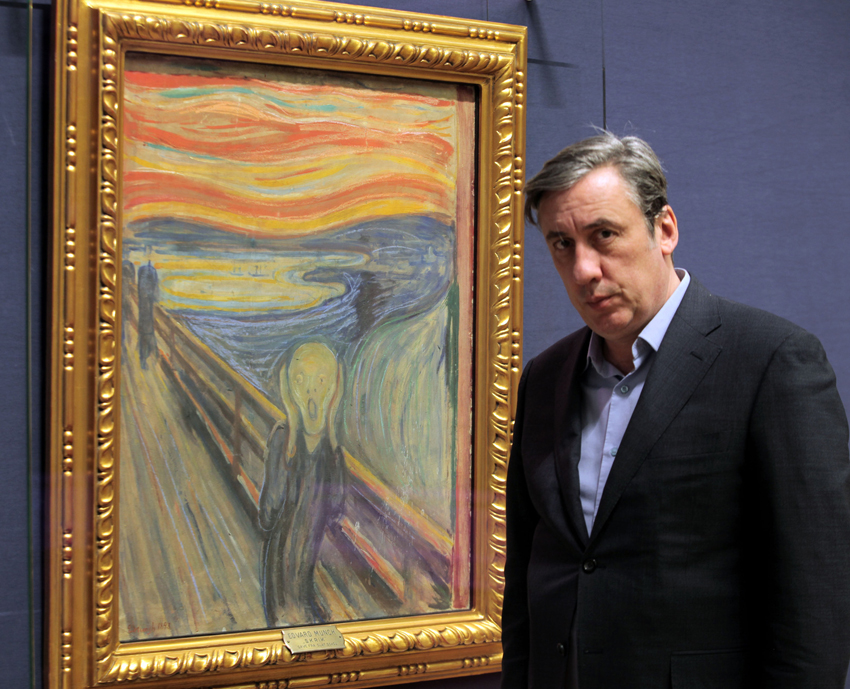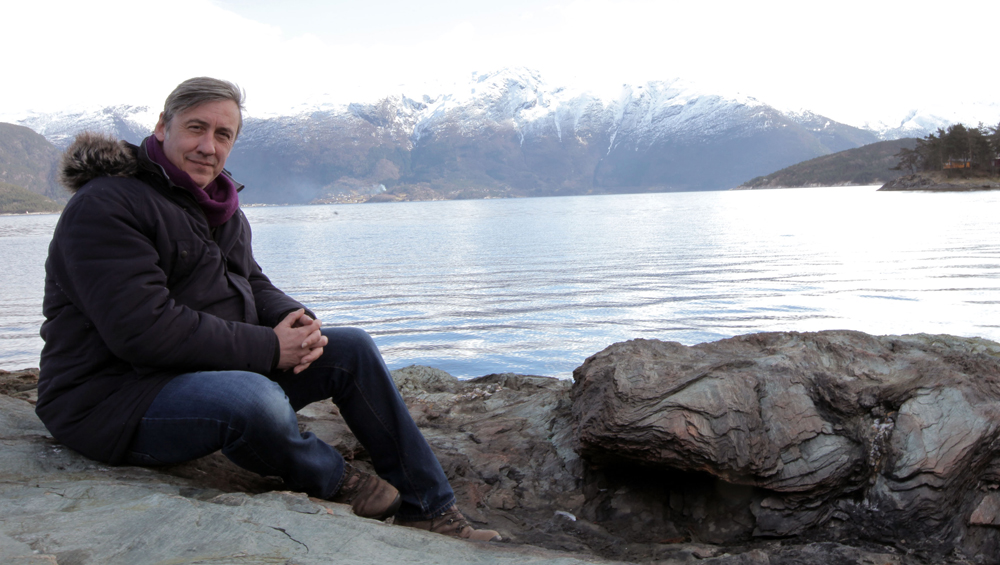Art of Scandinavia, BBC Four | reviews, news & interviews
Art of Scandinavia, BBC Four
Art of Scandinavia, BBC Four
TV's peripatetic art historian wallows in Nordic gloom and melancholia

Through the snowy wastes we crunched. The winter scenery was overwhelmingly beautiful and almost devoid of any human habitation: gorgeous mountains in the distance, the black waters of the fjords gleaming, the winter sun shining through the pale blue sky. And lo, here was Andrew Graham-Dixon, in woollen hat and furred windbreaker, to introduce us to centuries of Norwegian art.
The first episode of this three-part history focused exclusively on Norway, and was subtitled "The Dark Night of the Soul". What was exceedingly odd about the programme was its melodramatic pessimism, the narration accompanied by excessive mood music at every opportunity, and a determination to keep reminding us of the poverty-stricken centuries of the subsistence economy of Norway with its complementary inability to support the arts. Norway, a huge country with its magnificent indented west coast, but a tiny population, was described as being left off the map of world civilisations, with art, literature and philosophy belonging to the South.
Nobody would possibly guess that Norway is at the top of those endless surveys of national happiness
Norway evidently did not have culture, it had wilderness. It also had perpetual darkness – but Andrew, that's the winter, hadn’t you heard of the land of the midnight sun? The North in general and Norway in particular was a shadowland, with nature both enemy and inspiration, artists inspired by the frozen forms of ice. It was a country of stoicism and endurance, defined by anxiety, loneliness and melancholy.
To set the scene we opened with Edvard Munch’s world-famous The Scream (pictured below with dubious-looking presenter), controversially first exhibited in Norway in 1895. Munch’s own words were quoted, that fear sorrow and death had stood by him since the day he was born. Man was all alone in a hostile world. Did The Scream signify the modern age of anxiety?
Going back millennia, we were treated to some close-ups of Viking artefacts, beautifully carved, using bronze, iron, gold and wood. We detoured to the Viking Boat Museum in Oslo, with its magnificent long ship from Gokstad, and admired the extraordinary ingenuity of its carved and curved wooden body, each rib slotted into position; the Vikings had axes but no saws. There was a dramatic and touching visit to a big wooden stave church, some 800 years old, standing totally isolated in a vast panorama of uncultivated landscape, both setting and building quietly magnificent.
 By the late 18th and early 19th century Norway, like Europe and indeed the New World, had become fascinated with the sublime to be found in nature. Where the Frenchman had Paris, the Englishman London and the German Berlin, Norway had scenery; here we looked briefly at Johan Christian Dahl, who had indeed studied in Denmark and Germany, with his paintings of rocks and rainbows.
By the late 18th and early 19th century Norway, like Europe and indeed the New World, had become fascinated with the sublime to be found in nature. Where the Frenchman had Paris, the Englishman London and the German Berlin, Norway had scenery; here we looked briefly at Johan Christian Dahl, who had indeed studied in Denmark and Germany, with his paintings of rocks and rainbows.
Norway was under the aegis of Denmark for centuries, then Sweden, and not a fully independent country until the early 20th century. This political and social dependency helped explain the thrust of romantic nationalism in the 19th century, in art as in literature and other forms of expression. Henrik Ibsen got a look in (and if Ibsen, why not Grieg?) as did the new Oslo Opera House, looking like a fragmented iceberg by the side of the sea – its architects were not credited.
Meanwhile epic versions of the majestic North and its tempestuous seas depicted with strikingly imaginative techniques were closely explored in the mid-19th century paintings of Peder Balke. Balke, from a poverty-stricken background, was also a social activist – the recent large exhibition of his work at London’s National Gallery was not however mentioned. More mystical and even obscurely symbolic landscapes by Lars Hartevik were also looked at; this tragic figure had a breakdown when studying in Düsseldorf, was confined in Norway’s first lunatic asylum, and although long-lived never fully recovered, although he continued to paint. The outstanding 19th century Norwegian women painters were absent from Graham-Dixon’s pantheon.
Graham-Dixon reminded us of the trauma caused in an agrarian society by the industrial revolution, the mass migrations – notably across the Atlantic – of the 19th century, and claimed that in the 20th century Norway, with eventually (among other things) its unusually generous welfare state, was actively recoiling from the abyss that Munch’s art had revealed.
 He did not show us Norway in its spring and summertime, and seemed determined to emphasise misery and melancholia in the midst of icy grandeur. Graham-Dixon (pictured above, with fjord) suggested that when Norway woke up to the modern world, the country screamed. Munch’s Frieze of Life was, our guide said, about the alienation of souls lost in the whirlpool of city life, abandoned to hopeless passion. Somehow the existentialism of the Danish philosopher Kierkegaard also entered the mix.
He did not show us Norway in its spring and summertime, and seemed determined to emphasise misery and melancholia in the midst of icy grandeur. Graham-Dixon (pictured above, with fjord) suggested that when Norway woke up to the modern world, the country screamed. Munch’s Frieze of Life was, our guide said, about the alienation of souls lost in the whirlpool of city life, abandoned to hopeless passion. Somehow the existentialism of the Danish philosopher Kierkegaard also entered the mix.
The photography was glorious (Mike Garner its director) but the dramatic emphasis on Norwegian anxiety made the programme positively downbeat, our guide occasionally patronising. Nobody would possibly guess that Norway is at the top of those endless surveys of national happiness. There were moments when the viewer wondered why Graham-Dixon had even bothered to stomp through all that snow. It was produced and directed by Ian Leese; let us hope that next week’s Once Upon a Time in Denmark (Hans Christian Anderson? Now there’s a dark night of the soul) has Graham-Dixon in more positive mode. And what a help it would be to have labels of unfamiliar names and places.
Add comment
The future of Arts Journalism
You can stop theartsdesk.com closing!
We urgently need financing to survive. Our fundraising drive has thus far raised £49,000 but we need to reach £100,000 or we will be forced to close. Please contribute here: https://gofund.me/c3f6033d
And if you can forward this information to anyone who might assist, we’d be grateful.

Subscribe to theartsdesk.com
Thank you for continuing to read our work on theartsdesk.com. For unlimited access to every article in its entirety, including our archive of more than 15,000 pieces, we're asking for £5 per month or £40 per year. We feel it's a very good deal, and hope you do too.
To take a subscription now simply click here.
And if you're looking for that extra gift for a friend or family member, why not treat them to a theartsdesk.com gift subscription?
more TV
 theartsdesk Q&A: Suranne Jones on 'Hostage', power pants and politics
The star and producer talks about taking on the role of Prime Minister, wearing high heels and living in the public eye
theartsdesk Q&A: Suranne Jones on 'Hostage', power pants and politics
The star and producer talks about taking on the role of Prime Minister, wearing high heels and living in the public eye
 King & Conqueror, BBC One review - not many kicks in 1066
Turgid medieval drama leaves viewers in the dark
King & Conqueror, BBC One review - not many kicks in 1066
Turgid medieval drama leaves viewers in the dark
 Hostage, Netflix review - entente not-too-cordiale
Suranne Jones and Julie Delpy cross swords in confused political drama
Hostage, Netflix review - entente not-too-cordiale
Suranne Jones and Julie Delpy cross swords in confused political drama
 In Flight, Channel 4 review - drugs, thugs and Bulgarian gangsters
Katherine Kelly's flight attendant is battling a sea of troubles
In Flight, Channel 4 review - drugs, thugs and Bulgarian gangsters
Katherine Kelly's flight attendant is battling a sea of troubles
 Alien: Earth, Disney+ review - was this interstellar journey really necessary?
Noah Hawley's lavish sci-fi series brings Ridley Scott's monster back home
Alien: Earth, Disney+ review - was this interstellar journey really necessary?
Noah Hawley's lavish sci-fi series brings Ridley Scott's monster back home
 The Count of Monte Cristo, U&Drama review - silly telly for the silly season
Umpteenth incarnation of the Alexandre Dumas novel is no better than it should be
The Count of Monte Cristo, U&Drama review - silly telly for the silly season
Umpteenth incarnation of the Alexandre Dumas novel is no better than it should be
 The Narrow Road to the Deep North, BBC One review - love, death and hell on the Burma railway
Richard Flanagan's prize-winning novel becomes a gruelling TV series
The Narrow Road to the Deep North, BBC One review - love, death and hell on the Burma railway
Richard Flanagan's prize-winning novel becomes a gruelling TV series
 The Waterfront, Netflix review - fish, drugs and rock'n'roll
Kevin Williamson's Carolinas crime saga makes addictive viewing
The Waterfront, Netflix review - fish, drugs and rock'n'roll
Kevin Williamson's Carolinas crime saga makes addictive viewing
 theartsdesk Q&A: writer and actor Mark Gatiss on 'Bookish'
The multi-talented performer ponders storytelling, crime and retiring to run a bookshop
theartsdesk Q&A: writer and actor Mark Gatiss on 'Bookish'
The multi-talented performer ponders storytelling, crime and retiring to run a bookshop
 Ballard, Prime Video review - there's something rotten in the LAPD
Persuasive dramatisation of Michael Connelly's female detective
Ballard, Prime Video review - there's something rotten in the LAPD
Persuasive dramatisation of Michael Connelly's female detective
 Bookish, U&Alibi review - sleuthing and skulduggery in a bomb-battered London
Mark Gatiss's crime drama mixes period atmosphere with crafty clues
Bookish, U&Alibi review - sleuthing and skulduggery in a bomb-battered London
Mark Gatiss's crime drama mixes period atmosphere with crafty clues
 Too Much, Netflix - a romcom that's oversexed, and over here
Lena Dunham's new series presents an England it's often hard to recognise
Too Much, Netflix - a romcom that's oversexed, and over here
Lena Dunham's new series presents an England it's often hard to recognise

Comments
Enjoyed the series but why
Enjoyed the series but why didn't Finland feature? they have as much to offer as the other three countries.
Finns see themselves as
Finns see themselves as Nordic not Scandinavian.
No, we see ourselves as
No, we see ourselves as Scandinavian and Nordic.
No, most Finns don't see
I completely agree with your
I completely agree with your critique. The programme took such a particular stance, missing out so much, whilst including so many inaccuracies that I have not watched the following programmes yet, fearing that Sweden will be portrayed as a country of suicidal, wet nursed socialists, free lovers and Denmark as a nation of beer drinking, bicycle riding hippies. So, Norway had no renaissance and in particular no stain glass in churches. I wonder that he managed to find an example without. The renaissance in Norway can be found in church art, but then you need to look, so it is not surprising not to find it, after all the largest ecclesiastical building in Scandinavia, Trondheim Cathedral was not seen or mentioned. Even the Opera House was described as granite, actually of white marble, or did that seem too rich and southern. No mention of sculpture, perhaps Gustav Vigelands sculpture park is too well known and too big and popularist. No mention of furniture designers, such as Peter Opsvik, (TripTrap chair) whose ground breaking ergonomic and fun loving forms are both practical and joy giving. What about Grete Pritz Kittelsen, whose rich enamel creations have influenced many living designers, Benny Motzfeldt's glass creations. There is a wide range of designers and artists across the whole spectrum who have been honoured by the Jacob Prize, who disprove the programmes limited view. Norwegian architects have won many prestigious projects across the world, even in the UK (better not give British Airways publicity!) no mention of any of them. I wondered if all this was the responsibility of a poor researcher or a very specific pre-conceived view. Whatever, Mr Graham-Dixon took us down a long dark, fog filled tunnel, without any enlightenment. Perhaps he is just afraid of the freedom of the open air, if so he would not want to visit in summer, all those gregarious people in pavement cafes and harbours full of people messing about in boats.
Thank you Susan - for your
Thank you Susan - for your quote of Finland missing from that program totally! I was bit upset and very disappointed about it - as a Finnish national, living in UK. We have remarkable history in art and scandi design and very unique past thinking of the long era under first Sweden and then Russian rule. They have both strong impact in our art, music and culture.
And to William:
We have always considered our country being part of Scandinavia! Nordic countries and Scandinavia is for us all always those 4 countries together - even though there are some differencies between them but also loads of similarities. Unfortunately there are still many who don't seem to understand it because of our shared border with Russia.